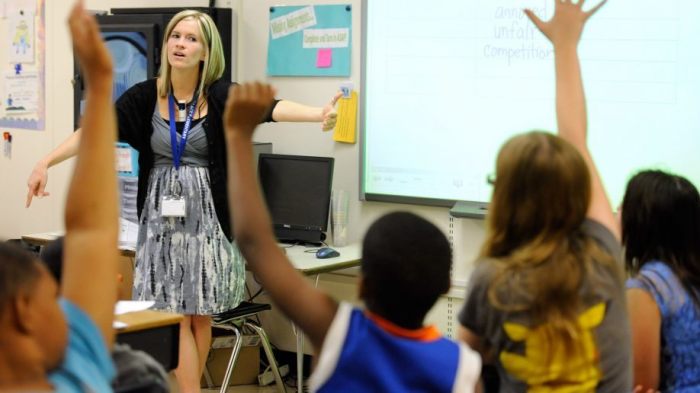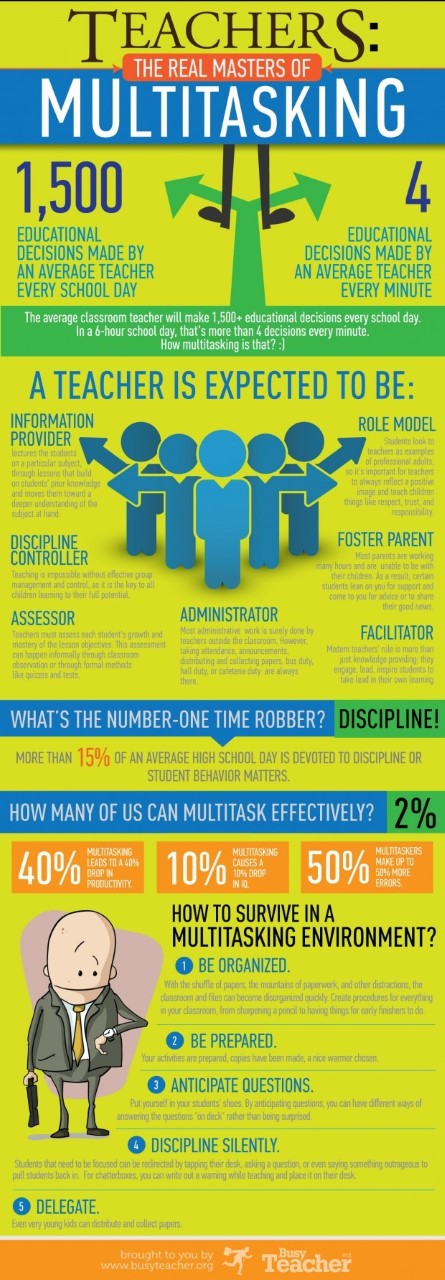
Teaching is an exhausting job.
If you’re a parent, you know how tiring it is with just one or two kids.
Imagine having a room full of them — Twenty to thirty children, each demanding your attention, each requiring your urgent help – every minute, every day, for hours at a time.
Back in the late 1980s, before education became totally absorbed by standardized testing and school privatization, we used to wonder about the effects of such need on a single individual.
We used to wonder how much was really being asked of our teachers.
Today no one outside of the classroom really gives it much thought. We think of educators as part of a vast machine that is required to give us and our children a service.
We’re stakeholders. They’re service providers. And the students are a national resource.
None of us are people.
Perhaps it’s this dehumanizing economic framework that’s helped the edtech industry and testing corporations make so much headway trying to replace educators with apps and iPads.
We no longer give the teacher an apple. We displace her with a Mac.
But back in the days before George W. Bush’s No Child Left Behind or Barrack Obama’s copycat Race to the Top, or Donald Trump’s blatant Destroy Public Education, we wondered about teacher psychology and how to best help our human workforce meet the needs of our human children.
That’s when researchers observed elementary school teachers and noted that, on average, they made at least 1,500 decisions a day.
That comes out to about 4 decisions a minute given six hours of class time.
In the decades since, this figure has come to be associated with elementary and secondary teachers. In fact, it’s become so ubiquitous that I wondered where it originated.
The first reference I can find to it comes from C.M. Clark & P.L. Peterson’s article “Teachers’ Thought Processes” published in the Handbook of Research on Teaching from 1986. (3rd ed., pp. 255–296). New York: macmillan.
Though subsequent studies came up with slightly different numbers, the basic argument holds.
Researchers Hilda Borko, Carol Livingston and Richard Shavelson mark the low end of the scale. In their 1990 article “Teachers’ Thinking About Instruction,” they summarize studies that reported .7 decisions per minute during interactive teaching or 42 judgements per hour, 252 a day.
On the upper end of the scale is Philip Jackson who wrote in his 1990 book “Life in Classrooms” that elementary teachers have 200 to 300 of these determination generating exchanges with students every hour (between 1,200-1,800 a day). Most of these are unplanned and unpredictable calling for teachers to make what they term shallower decisions or deeper judgments (p. 149).
So because teaching involves waiting for the right opportunities for learning, neither student nor teacher can say with confidence what exactly will happen next. It requires “spontaneity and immediacy” (Jackson, p. 166, 152).
As a classroom teacher with more than 15 years of experience, none of this is surprising to me.
Just imagine the various tasks teachers are required to do every hour. We take attendance, review homework, help with seat-work, ask questions, etc. And that doesn’t even take into account all the times we’re unpredictably interrupted by the unexpected – upset students, administrative announcements over the PA, student questions, equipment breakdowns, etc. Each one of these requires us to make spontaneous, unplanned calls before the lesson can continue.
It just goes to show some of the various roles teachers are expected to fill in the lives of their students. They are expected to be information providers, disciplinarians, assess student learning, administrate school policies, facilitate student inquiry, act as role models and even be foster parents.
In any given lesson, we have to make decisions based on our plans AND decisions based on things that just happen to crop up unexpectedly – multiple times each day.
In fact, it seems to me that the research fails to account for innumerable situations that also require determination and deliberation as part of an educator’s everyday routine.
What about curriculum and instruction design? Grading? Written and verbal feedback to students? Reflection and revision of lesson plans?
When you think of all that, 1,500 decisions a day seems like a conservative estimate indeed.
Perhaps the most troubling thing about this is where it impacts teacher quality.
And when I say that, I don’t mean the basterdized modern meaning of that term – that teachers are responsible for maximizing student test scores on standardized assessments. I mean the quality of authentic instruction teachers are able to give their classes.
When we expect educators to turn on a dime more than a thousand times a day, doesn’t that impact the depth with which we can accomplish the job?
Busyteacher.org certainly thinks so. I’m not sure where the Website got its statistics, but they are sobering.
In a fascinating infographic, the site claims that multitasking leads to a 40% drop in productivity. It causes a 10% drop in IQ. It causes people to make 50% more mistakes than concentrating on one task at a time.

I don’t know if these statistics are accurate, but the general principle is sound. When we’re forced to “do more with less” we actually end up producing more with less quality.
Focusing on fewer things increases ones accuracy. Therefore, teachers who have to make fewer decisions in a day would probably be able to do their jobs more effectively.
And there are plenty of ways to accomplish this.
We could reduce class size. If educators can concentrate on the needs of fewer children, they would be more effectively able to meet those needs.
We could reduce the amount of time teachers have to be in the classroom in a given day. I’ve often thought teaching was analogous to being an actor up on the stage – but we’re also responsible for writing the script, operating the lighting, etc. And we have to interact with the audience many of whom would rather be elsewhere, and we have to do multiple shows each day.
In some countries, teachers spend a significant part of their days planning and grading and less in the classroom. They don’t have to do all that behind the scenes stuff on their own time without any additional pay.
In Finland, for example, teachers are paid 13% more than the Organization for Economic Cooperation and Development (OECD) average but spend 100 hours less in the classroom. And class size is between 9-14 students, the lowest in OECD countries. No wonder their children are near the top of the scale in international comparisons!
Wouldn’t it be amazing if we lived in a society that valued education and didn’t try to turn everything into economic quantities for corporations?
We could actually focus on the real phenomena of educating children and not have to fight warped education policies more concerned with turning it all into dollars and cents.
Perhaps teachers wouldn’t have to make so many thousands of decisions if our lawmakers could just make this one.
Still can’t get enough Gadfly? I’ve written a book, “Gadfly on the Wall: A Public School Teacher Speaks Out on Racism and Reform,” now available from Garn Press. Ten percent of the proceeds go to the Badass Teachers Association. Check it out!


And in America, at least, teachers are now increasingly being asked to be security as well. I’ve heard suggestions about giving teachers guns so as to keep their students “safe.” If teachers are expected to play so many roles and make so many decisions, we should pay them as such.
LikeLike
You’ve got a point here, Brendan. Now we don’t just have decide when to let a kid use the bathroom but when to take out a gun and shoot to kill. That’s decision making of a whole different caliber!
LikeLiked by 1 person
Yes, that’s a decision of a whole different (and potentially, really dangerous) caliber. After all, not everyone knows how to use a gun, and teachers were trained to teach!
LikeLike
The only thing these policy makers seem to care about is how to pass the buck. And how to make a fistful.
LikeLiked by 1 person
Sadly, you’re right.
LikeLike
Reblogged this on David R. Taylor-Thoughts on Education.
LikeLike
[…] How Many Decisions Do Teachers Make Every Day? […]
LikeLike
[…] As decisões de um professor […]
LikeLike
I stopped reading as soon as I got to “Donald Trump’s blatant Destroy Public Education”. Not all educators agree with this statement. I teach at a public school but support school choice. I certainly do not believe our President is trying to destroy public education either.
LikeLike
Mrs. B, you need to read more. Betsy DeVos said in her position as Secretary of Education that public school is a dead end. She has been striping children of their rights while giving away the store to charter and voucher schools. Destroying public education is their policy. This is not a guess. It is not a conspiracy. It’s their stated goal. Teacher, educate thyself.
LikeLike
[…] If you have students and aren’t in immediate danger, you’re expected to teach them. […]
LikeLike
Well, now I know why I’m exhausted – I’m making so many decisions every day! This also explains why I can’t decide what to make for dinner: My brain is spent by 4:00! Thanks for this article!
LikeLike
You’re welcome. I’m in the same boat. What to make for dinner is one of the hardest decisions of the day!
LikeLike
[…] For me, the answers were unequivocally positive. I took to it like I’d taken to journalism. I needed lots of fine tuning, but the basics came naturally. And I loved every exhausting minute of it. […]
LikeLike
[…] to myself to be always vigilant with my words. This is so hard to do in the rush and bustle of making an average of four decisions a minute, but Christian’s presence in my life reminds me of the importance of putting the students at […]
LikeLike
[…] offices. As this transformation took place, it accompanied greater trust in administrators and decreasing confidence in classroom teachers. And if you don’t see the sexism in that, you aren’t paying […]
LikeLike
[…] the current system, only 50 percent of state teachers annual evaluations come from observations of what they actually do in the classroom. The rest comes from student test scores and other factors that are out of their […]
LikeLike
[…] even after counting all my blessings, I still can’t do whatever I want. I can’t even do everything that my years of academic training and experience tells me would be best for my […]
LikeLike
[…] As every teacher knows, you start small, scaffold your lessons from point A to B to C and make whatever changes you need along the way. […]
LikeLike
[…] kind of tension among teachers has consequences. More than half of educators reported that they have less enthusiasm now than at the beginning of […]
LikeLike
[…] That can’t be done at a distance through any top-down directive. It must be accomplished in the moment using skill, empiricism and experience. […]
LikeLike
[…] Yet I feel compelled to say it anyway. […]
LikeLike
[…] I had my laptop with me and was frantically trying to get everything ready that I’d need for the day. […]
LikeLike
[…] How Many Decisions Do Teachers Make Every Day? […]
LikeLike
[…] 2) How Many Decisions Do Teachers Make Every Day? […]
LikeLike
[…] But being a teacher I can’t help thinking about what’s to come next. […]
LikeLike
[…] This presents a problem. Do I explain the error and ask him to to do the work all over again? Or do I explain the error but a… […]
LikeLike
[…] let me be clear – I’m not saying my way was the only way. Each teacher has his or her own way of doing things that work in their particular cases. But as for me, I’ve always agreed with the old adage that you should come dressed for the job […]
LikeLike
[…] How Many Decisions Do Teachers Make Every Day? by Steven M. Singer […]
LikeLike
[…] help kids learn to read and write. I open them up to new possibilities and give them opportunities to express […]
LikeLike
[…] How Many Decisions Do Teachers Make Every Day? by Steven M. Singer […]
LikeLike
[…] they do, they soon realize that teaching isn’t the place for them. There is so much we have to do everyday – from grading papers, to counseling students, to calling parents, to scaffolding group work, […]
LikeLike
Hey Steven–
Thanks for this, which I am coming to accidentally while trying to number our decisions for this poem I’m submitting. I know you from various Twitter and BadAss events, and I appreciate your being here in our teacher universe. It’s my last year in the full-time classroom workin for The Man, and then I plan an essay on how invisible our work is to the general public because we work essentially alone, without the witness even of other adults, and it’s impossible to make anything like a realistic movie or TV show about a classroom. Would love to talk with you about that sometime.
[poem format will not stick in a comment but you get the idea]
************
Class Work
This is labor of the lowest, bareknuckle class:
the hefting and heaving
of the dock worker or trucker
as we haul in rolled-up rugs, drag
small but solid sinks and stoves into place
the bending and stretching
of the farmer or fruit picker
as we tie the same shoes over and over, hang
glittering fish from the ceiling
the sorting and stacking, shuffling and piling
of the secretary or stock clerk
as we stuff folders with important forms, fill
labeled shelves with puzzles, pebbles, paper
And all the while the labor of 1500 split-second
decisions per day: address or ignore? just one,
a few or all? faster or slower? now
or later? elaborate or simplify? sharp voice or soft?–
And all the while a bear-down, breath-taking kind of labor
that pushes each child further into
the light of the world, eyes wide open,
fingers unfurling, grasping at tools for
the labor of becoming
LikeLike
[…] The list is truly staggering. And it never stops. Researchers have estimated that on average teachers make at least 1,500 decisions a day. That’s about 4 decisions a minute. No one can keep up that pace, day-in, day-out, without […]
LikeLike
[…] I can even think about cooking dinner. I don’t love the paralysis every tiny decision gives me after making thousands of choices all day long in class. I don’t love missing giant chunks of my family’s […]
LikeLike
[…] more being on stage every moment but instead having dedicated times untethered to students where you can actually think about things – how to teach this or that, what students really meant when they made certain comments, how […]
LikeLike
[…] It is important to differentiate instruction but there is only so much differentiation a single person can do effectively. […]
LikeLike
[…] I used to make badly behaved students stay 15 minutes after school for detention. It’s not something I do so much these days but I was a new teacher then – strict and consumed with reciprocal justice. In fact, students had to WORK during my detentions. No sleeping or even doing homework. They had to copy definitions out of the dictionary for the full time. If they slacked off, I added more time. Some days a 15-minute detention could last an hour, because if I reported that they hadn’t satisfied me, the principal would keep them on the weekend or in a longer detention during the week with an administrator. […]
LikeLike
[…] without instruction – and there can be marvelous gains by some students in this way. However, teachers are there for a reason. We know the curriculum and many avenues to understanding it. We can point students many ways to […]
LikeLike